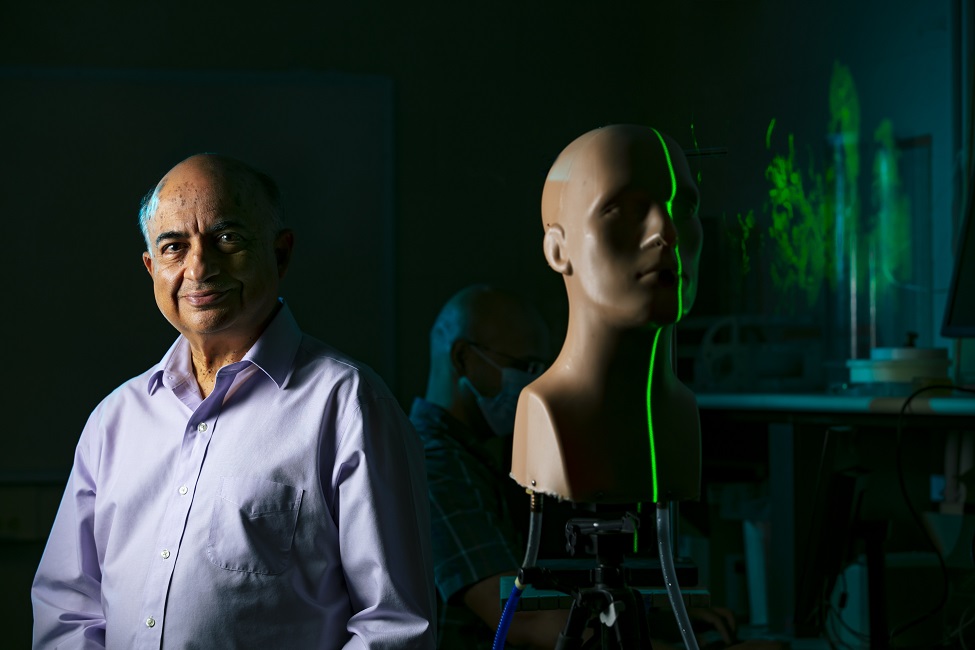FAU Gets CDC Grant to Test PPE Efficacy and Workplace Virus Spread

Manhar Dhanak, Ph.D., principal investigator, chair of FAU’s Department of Ocean and Mechanical Engineering, and professor and director of SeaTech, is shown with the mannequin they designed to demonstrate how far aerosolized droplets travel from coughs and sneezes, which were mechanically emulated through pumping a mixture of air and mist/fog from its mouth. (Photo by Alex Dolce)
With many businesses and schools in the United States now open post COVID-19, employers are faced with new challenges to keep the workplace safe for their employees, customers and students. Researchers from Florida Atlantic University’s College of Engineering and Computer Science have received a two-year $698,801 grant from the U.S. Centers for Disease Control and Prevention (CDC) to test the effectiveness of various types of personal protection measures against airborne viral transmission. Building on their prior research, the project will result in experimentally verified computational strategies for mitigating airborne transmission of aerosolized droplets for a safe workplace environment.
Researchers will test and quantify the effectiveness of various protective measures under new American Society for Testing Materials standards and best safety practices in the workplace. They will evaluate facemasks and other personal protection equipment; physical safety barriers; interior designs of spaces; air filters, humidifiers; safe seating arrangements in a classroom setting and queuing at checkouts, as well as other measures.
“Employers are considering various protective measures in the workplace such as facemasks, placing safety barriers in offices and at workstations, reviewing ventilation/air conditioning systems in buildings, redesigning interior spaces as well as arranging safe queuing procedures at checkouts and other high-density environments,” said Manhar Dhanak, Ph.D., principal investigator, chair of FAU’s Department of Ocean and Mechanical Engineering, and professor and director of SeaTech. “With this CDC grant, we will conduct experimental simulation studies that will result in observations and analyses in support of social distancing and other preventative measures for mitigating airborne transmission of viral infections, which will be of particular interest to businesses, schools and the general public.”
In their prior studies, Dhanak and Siddhartha Verma, Ph.D., co-principal investigator and an assistant professor in the Department of Ocean and Mechanical Engineering, qualitatively investigated the spread of aerosolized droplets from coughs and sneezes that were mechanically emulated through pumping a mixture of air and mist/fog from the mouth of a mannequin. The process generates puffs of air containing aerosolized droplets that are representative of the smaller droplets typically present in respiratory exhalations. Their visualization of airflow revealed the structure and evolution of the unobstructed air puffs and show that in still air, aerosolized droplets can travel distances of more than 12 feet from the source and remain suspended in the air for several minutes.
“Previous public health guidelines have suggested social distancing of a minimum of 6 feet to mitigate airborne transmission of virus-carrying saliva droplets from infectious coughs, sneezes and exhalations,” said Verma. “These aerosolized droplets range in size, with the larger droplets generally falling to the ground within 6 feet. However, our research has shown that much smaller droplets can remain suspended in the air for a significant amount of time and can travel far.”
Dhanak and Verma also examined the efficacy of various types of commonly available facemasks in mitigating the spread of aerosolized droplets as well as the effectiveness of a face shield, with and without a facemask, as a measure to protect others. Their latest study investigated droplets generated from flushing a toilet and a urinal in a public restroom under normal ventilation conditions. Results demonstrate how public restrooms could serve as hotbeds for airborne disease transmission, especially if they do not have adequate ventilation.
With this CDC grant, Dhanak and Verma plan to develop a state-of-the-art testing facility for flow visualization-based studies of transmission of aerosol-sized droplets, which can be quantified in terms of droplet size and density distribution, including improved emulation of respiratory exhalations. Because the role of heating, ventilation and air conditioning systems as a measure for controlling airborne transmission of viral infections is well recognized, they also will quantify the effect of ventilation in the laboratory setting. Furthermore, to support architects who are looking to redesign buildings and interior spaces in a post-COVID-19 world, they will examine the transmission of the respiratory droplets under various mockup setups of interest in a range of environmental conditions.
“There has been much debate about social distancing, wearing facemasks or face shields as well as how far airborne transmission of virus-carrying saliva droplets can travel,” said Stella Batalama, Ph.D., dean, College of Engineering and Computer Science. “With their cutting-edge COVID-19 research, professors Dhanak and Verma have illuminated the world with their simulation experiments and visualization of the flow patterns of aerosolized droplets. This grant from the CDC will help to propel their research to the next level, which will ultimately enhance public safety and mitigate the unnecessary spread of infectious diseases at school, in the workplace and at other public venues.”
-FAU-
Tags: technology | research | engineering | faculty and staff